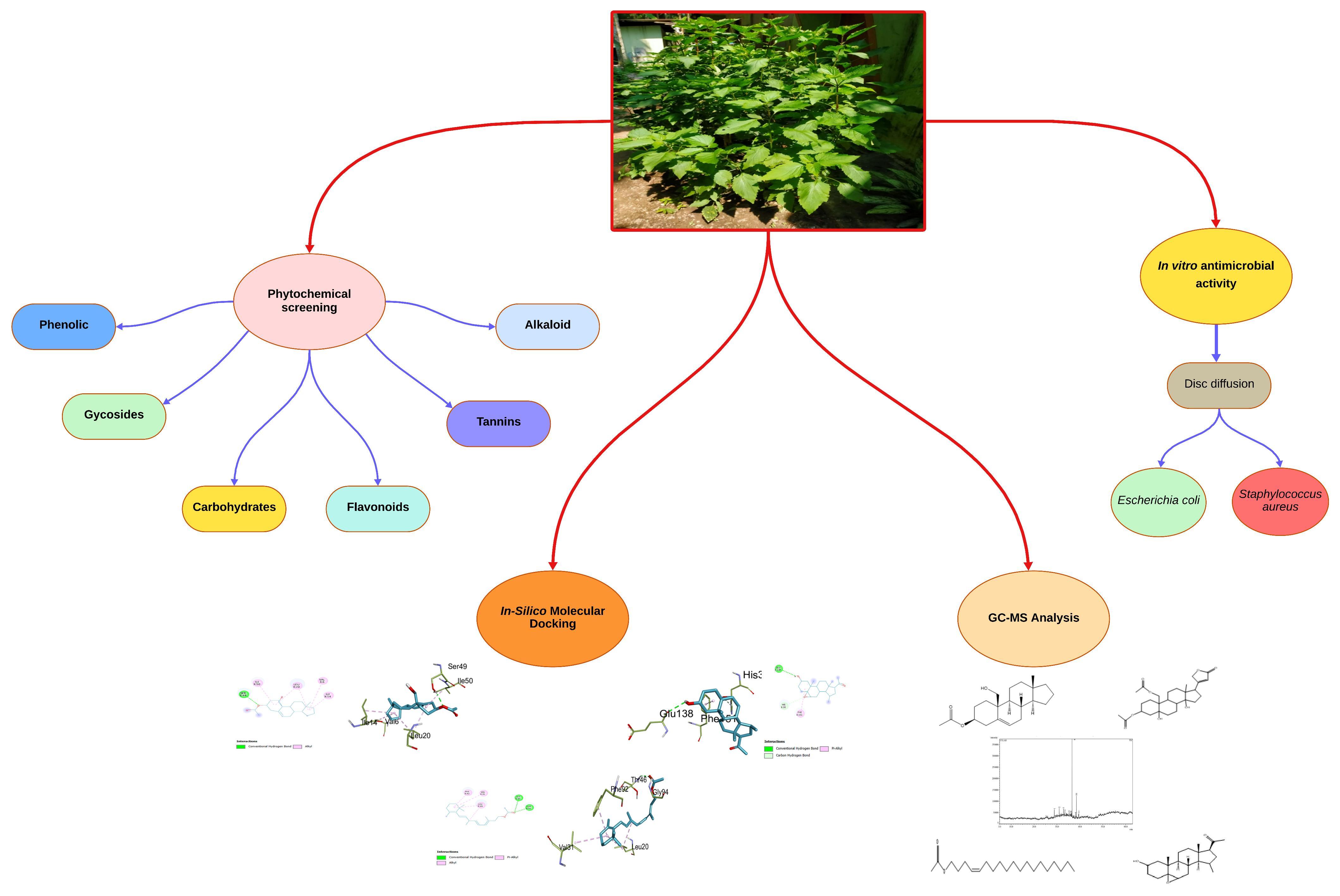Antimicrobial potential, GC-MS analysis, and molecular docking studies of Pogostemon benghalensis leaf extract
DOI:
https://doi.org/10.69857/joapr.v13i4.833Keywords:
Pogostemon benghalensis, GCMS analysis, Phytochemical screening, Molecular dockingAbstract
Background: Pogostemon benghalensis has several medicinal uses in Northeast India, including wound healing activity. Currently, no molecular modeling research has examined the antimicrobial potential of its phytoconstituents. This molecular docking research identifies bioactive chemicals and evaluates their antibacterial properties. Methodology: Phytochemical screening and in vitro antibacterial tests were performed on a crude ethyl acetate extract of Pogostemon benghalensis leaves. After GC-MS analysis revealed the phytoconstituents, in-silico molecular docking was performed against the dihydrofolate reductase (DHFR) enzymes of Escherichia coli and Staphylococcus aureus. Results and discussion: The crude ethyl acetate extract of Pogostemon benghalensis leaves included alkaloids, carbohydrates, flavonoids, glycosides, tannins, and phenolic compounds. The extract also demonstrated potent in vitro antibacterial activity against E. coli and S. aureus. GC-MS data demonstrated that Phytol was the most abundant compound (53.72%) followed by Oxirane, dodecyl (13.51%.). Molecular docking studies demonstrated identified compounds have high binding affinity (BA) to the bacterial DHFR enzyme. Notable compounds are Androst-5-ene-3,19-diol, 3-acetate (3 β) with -7.4 kcal/mol BA against E. coli DHFR and -10.1kcal/mol against S. aureus DHFR; Retinol acetate with -8.7 kcal/mol BA against E. coli DHFR and Phytol with -6.5 kcal/mol BA against E. coli DHFR and -6.7 kcal/mol BA for S. aureus DHFR respectively. Conclusion: The results show that Pogostemon benghalensis contains valuable bioactive compounds with high antibacterial activity which further validates the use of this plant as a wound healing medication. However, further in vivo experimental validation of these results and their toxicological implications are required.
Downloads
References
Chaudhury G, Basumatari M, Darji CB, Ahmed AF, Borah D, Sah RK, Devi A, Hazarika N, Dutta G. Economic significance of wild bioresources to rural communities in the Eastern Himalayan state of Assam, Northeast India. Trees, Forests and People, 5, 100102 (2021) https://doi.org/https://doi.org/10.1016/j.tfp.2021.100102.
Barbhuiya PA, Laskar AM, Mazumdar H, Dutta PP, Pathak MP, Dey BK, Sen S. Ethnomedicinal Practices and Traditional Medicinal Plants of Barak Valley, Assam: a systematic review. J Pharmacopuncture, 25, 149–85 (2022) https://doi.org/10.3831/KPI.2022.25.3.149.
Begum K, Mylliemngap W, Lyngdoh N. Quantitative ethnobotanical analysis of ethnomedicinal flora used by the Eastern Himalayan Indigenous Communities of Assam, India. Ethnobotany Research and Applications, 27, (2024) https://doi.org/10.32859/era.27.43.1-39.
Kala CP. Traditional Health Care Systems and Herbal Medicines. Eur J Environ Public Health, 1, (2017) https://doi.org/10.20897/ejeph.201703.
Pimpliskar MR, Jadhav R, Ughade Y, Jadhav RN. Preliminary phytochemical and pharmacological screening of Pogostemon benghalensis for antioxidant and antibacterial activity. Asian J Pharm Pharmacol, 7, 28–32 (2021) https://doi.org/10.31024/ajpp.2021.7.1.7.
Dahiya S, Batish DR, Singh HP. Phytotoxicity of essential oil of Pogostemon benghalensis and its potential use as bioherbicide. Vegetos, 34, 807–13 (2021) https://doi.org/10.1007/s42535-021-00262-6.
Aryal S, Adhikari B, Panthi K, Aryal P, Mallik SK, Bhusal RP, Salehi B, Setzer WN, Sharifi-Rad J, Koirala N. Antipyretic, Antinociceptive, and Anti-Inflammatory Activities from Pogostemon benghalensis Leaf Extract in Experimental Wister Rats. Medicines (Basel), 6, 96 (2019) https://doi.org/10.3390/medicines6040096
Yang Y, He PY, Zhang Y, Li N. Natural Products Targeting the Mitochondria in Cancers. Molecules, 26, (2021) https://doi.org/10.3390/molecules26010092.
Bhattacharya A, Verma AK, Rao S, Momin SG, Radhakrishnanand P, Sarkar P. Unlocking the phytochemicals in unopened pitcher fluids of Nepenthes khasiana -a GC–MS study. Intelligent Pharmacy, 2, 284–90 (2024) https://doi.org/10.1016/j.ipha.2023.10.005.
Srikacha N, Ratananikom K. Antibacterial activity of plant extracts in different solvents against pathogenic bacteria: An in vitro experiment. Journal of Acute Disease, 9, 223 (2020) https://doi.org/10.4103/2221-6189.291288.
Manayi A, Rastegari A, Heydarian B, Vahedi-Mazdabadi Y, Khanavi M, Akbarzadeh T, Saeedi M. Phytochemical investigation and biological activity of Doronicum pardalianches L. roots against Alzheimer’s disease. Nat Prod Res, 37, 1227–31 (2023) https://doi.org/10.1080/14786419.2021.1999944.
Jajo H, Baishya T, Das P, Ashraf GJ, Dua TK, Paul P, Nandi G, Sahu R. GC-MS and HPTLC bioautography-based phytochemical profiling and evaluation of biological activity Neptunia prostrata Linn whole plant and leaves. Pharmacological Research - Natural Products, 2, 100013 (2024) https://doi.org/10.1016/j.prenap.2024.100013.
Gogoi R, Sankar S, Deka S, Talukder A. Pharmacological Research - Natural Products Determination of chemical composition , antimicrobial activity and in silico investigation of the essential oil extracted from peels of Citrus medica ( Jora Tenga ) & Citrus jambhiri ( Gol Nemu ) grown in north . Pharmacological Research - Natural Products, 6, 100139 (2025) https://doi.org/10.1016/j.prenap.2024.100139.
Manandhar S, Luitel S, Dahal RK. In Vitro Antimicrobial Activity of Some Medicinal Plants against Human Pathogenic Bacteria. J Trop Med, 2019, 1895340 (2019) https://doi.org/10.1155/2019/1895340
Mohamed EAA, Muddathir AM, Osman MA. Antimicrobial activity, phytochemical screening of crude extracts, and essential oils constituents of two Pulicaria spp. growing in Sudan. Sci Rep, 10, (2020) https://doi.org/10.1038/s41598-020-74262-y.
Sandhiya U, Manikandan T, Thavamurugan S, Kavipriya MR, Pavithra SK, Lakshmi Prabha AM. Profiling bioactive compounds of Pogostemon benghalensis (Burm.f.) Kuntze and its antibacterial activity. Vegetos, 37, 144–54 (2023) https://doi.org/10.1007/s42535-022-00557-2.
Pimpliskar MR, Jadhav R, Ughade Y, Jadhav RN. Preliminary phytochemical and pharmacological screening of Pogostemon benghalensis for antioxidant and antibacterial activity. Asian J Pharm Pharmacol, 7, 28–32 (2021) https://doi.org/10.31024/ajpp.2021.7.1.7.
Arjun B, Amrita A, Dikshya B, Jalapa G, Manisha G. Comparative in-vitro study on phytochemical profile, antioxidants, and antimicrobial activities of Pogostemon benghalensis leaves and stem from two different geographical regions at Lumbini Province of Nepal. Journal of Medicinal Plants Research, 18, 95–106 (2024) https://doi.org/10.5897/JMPR2024.7352.
Sehrawat R, Pasrija R, Rathee P, Kumari D, Khatkar A. Molecular modeling, synthesis and biological evaluation of caffeic acid based Dihydrofolate reductase inhibitors. BMC Chem, 18, 242 (2024) https://doi.org/10.1186/s13065-024-01355-4.
He J, Qiao W, An Q, Yang T, Luo Y. Dihydrofolate reductase inhibitors for use as antimicrobial agents. Eur J Med Chem, 195, 112268 (2020) https://doi.org/10.1016/j.ejmech.2020.112268.

Published
How to Cite
Issue
Section
Copyright (c) 2025 Bhaswati Kashyap, Siddhartha Sankar Das, Dipjyoti Sharma, Nilutpal Sharma Bora, Sameeran Gam, Koushik Nandan Dutta

This work is licensed under a Creative Commons Attribution-NonCommercial 4.0 International License.
















